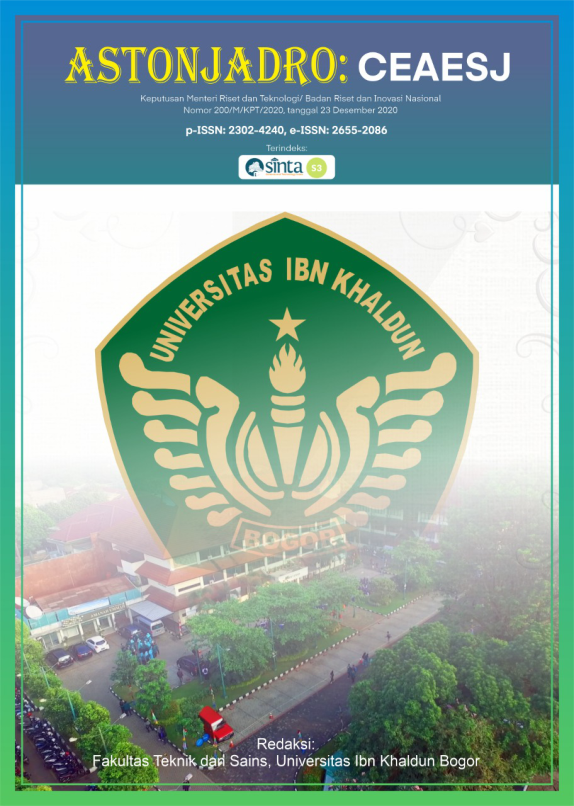GUBENG STATION RAILWAY INFRASTRUCTURE PERFORMANCE ACCORDING TO USER PERCEPTION
DOI:
https://doi.org/10.32832/astonjadro.v9i2.3154Keywords:
train, perception, woman, station, IPA.Abstract
Gubeng Station is the most populous station of 52 stations that enter the work area of PT KAI Daop 8 Surabaya, with 978,346 train passengers in January 2019, where this number is the highest number of train passengers for 3 years recorded at Gubeng station. Gubeng Station is also very unique, because it is located at a height of 5 meters and has two functionally different sides. The west side building is used for the departure and arrival of economy and express trains, while the east side building is for the departure and arrival of business and executive trains. This functional difference needs to be a study of the provision of infrastructure/facilities available at the Gubeng station whether it meets the minimum train service standards and has provided services/satisfaction and the importance of the existing facilities at the Gubeng station according to the train user perception. The method used is importance performance analysis (IPA) and the conclusion is that satisfaction and importance of the existing facilities at Gubeng station according to the train user perception obtained a satisfaction value of 2.48 which means that they still do not get maximum service and the average value of interest is 4.57 which means that the existing facilities at Gubeng station are needed by train passengers.References
Anonim, Peraturan Menteri Perhubungan Republik Indonesia nomor PM 27 tahun 2012 Tentang Perubahan Atas Peraturan Menteri Perhubungan Nomor PM 10 Tahun 2012 Tentang Standar Pelayanan Minimal Angkutan Massal Berbasis Jalan
Badan Pendidikan dan Latihan Perhubungan Pusat Pendidikan dan Latihan Perhubungan Darat, 1995, ”Teknik Survai Lalu Lintas dan Angkutan Jalan (16 JT + 56 JP)”, Jakarta.
Brandt, D.R. 2000, An Outside-In Approiach to Determining Customer-Driven Priorities for Improvement and Innovation, White Paper Series, Volume 2
Departemen Perhubungan Darat, 2008, ”Perencanaan Teknis Penentuan dan Penetapan Demand Jaringan Pelayanan AKAP di Pulau Jawa”, Jakarta.
Departemen Perhubungan Darat, 2005, ”Pedoman Kriteria Transportasi Berkelanjutan”, Jakarta.
Keputusan Mentri Perhubungan Nomor: KM.89, 2002, ”Mekasinme Penetapan Tarif dan Formula Perhitungan Biaya Pokok Angkutan Penumpang dengan Mobil Bus Umum Antar Kota Kelas Ekonomi”, Jakarta.
Lloyd Wright, 2002, , ”Modul 3b Angkutan Bus Cepat”, Penerbit Deutsche Gesellschaft fur Technische Zusammenarbit (GTZ), Jerman.
Miro, Fidel, 2005, ”Perencanaan Transportasi untuk Mahasiswa, Perencana, dan Praktisi”, Penerbit Erlangga, Jakarta.
Munawar, A, 2007, "Pengembangan Transportasi yang Berkelanjutan”, pidato pengukuhan jabatan guru besar pada fakultas teknik Universitas Gadjah Mada.
Nasution, HMN, 1996, ”Manajemen Transportasi”, Penerbit Ghalia Indonesia, Jakarta.
Salim, Abbas, 1993, ”Manajemen Transportasi”, Penerbit PT. Grafindo, Jakarta.
Tamin, O.Z., 2000, ”Perancanaan dan Pemodelan Transportasi”, Penerbit ITB, Bandung.
Yafiz, M, 2002, ”Analisis Kinerja Jasa Transportasi Angkutan Kota di Kota Pekanbaru”, Makalah Falsafah Sains Program Pasca Sarjana Institut Pertanian Bogor.
Syaiful Syaiful, Sri Wiwoho Mudjanarko, 2019, Noise of Motor Vehicles at from of Baiturrahman Great Mosque Semarang City, The Spirit Of Society Journal, 2 (2) March 2019. https://jurnal.narotama.ac.id/index.php/scj/article/view/902
Hana Karimah dan Juang Akbardin, 2019. KAJIAN TENTANG MODEL BANGKITAN PERGERAKAN ERMUKIMAN KAWASAN CIWASTRA KOTA BANDUNG, ASTONJADRO Jurnal Rekayasa Sipil, 8(2),pp.97-102. http://ejournal.uika-bogor.ac.id/index.php/ASTONJADRO/article/view/2799
Cicilia Fransisca Ganda, Hary Moetriono, Sri Wiwoho, 2019. ANALISIS ALTERNATIF PEMBIAYAAN PENYEBERANGAN ASDP UJUNG-KAMAL AKIBAT DIBANGUNNYA JEMBATAN SURABAYA-MADURA. ASTONJADRO Jurnal Rekayasa Sipil, 8(2),pp.103-109. http://ejournal.uika-bogor.ac.id/index.php/ASTONJADRO/article/view/2801/1681
Downloads
Published
How to Cite
Issue
Section
License
Paper submitted to ASTONJADRO is the sole property of the Astonjadro Journal. Unless the author withdraws the paper because he does not want to be published in this journal. The publication rights are in the journal Astonjadro.ASTONJADRO
LICENSE
This work is licensed under a Creative Commons Attribution-ShareAlike 4.0 International License.
Based on a work at http://ejournal.uika-bogor.ac.id/index.php/ASTONJADRO













